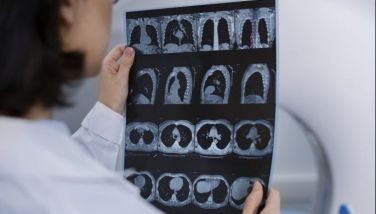A journey to the heart of Islam
October 25, 2003 | 12:00am
 For five days in the last month of the Islamic calendar, Muslims around the world flock to Mecca in Saudi Arabia to fulfill the hajj, one of the Five Pillars of Islam, which are acts of worship essential to the lives of Muslims. The hajj is required of all who are capable of it at least once in their lifetime.
For five days in the last month of the Islamic calendar, Muslims around the world flock to Mecca in Saudi Arabia to fulfill the hajj, one of the Five Pillars of Islam, which are acts of worship essential to the lives of Muslims. The hajj is required of all who are capable of it at least once in their lifetime.
It is estimated that close to two million Muslims from around the world observe the hajj annually. Muslims travel to Mecca to praise and give thanks to God, to ask pardon for their sins and renew their spiritual commitment through an elaborate series of rites and rituals.
For non-Muslims, the hajj is shrouded in mystery. Annual reports on the hajj often detail deaths, usually from sunstroke or from being accidentally trampled by the crowd.
National Geographic premieres on Oct. 27, at 8 p.m., the documentary Inside Mecca, which captures the look and feel, spiritual upliftment, claustrophobia, grandeur and grit of this largest gathering of Muslims around the world.
Award-winning reporter and filmmaker Anisa Mehdi directs and produces this new documentary film.
In an interview in Malaysia prior to the opening of the National Geographic-organized photo exhibit Inside Mecca at the National Museum of Malaysia, Mehdi tells a group of Asian journalists the travails and triumphs of undertaking this important project.
An American Muslim of Arab descent, Mehdi says the hajj has always been one of her dream projects.
"This project came to me quite by accident," she says. "I got a call from National Geographic in May last year asking me if I wanted to do a documentary on the hajj. It was just like this project came to me."
Mehdi is just the right person for the project. As a Muslim and American of Arab descent, she has been reporting on Middle East conflict resolution. She is also the first American woman to report on the hajj on location in Mecca for US television and was one of the first reporters to cover the blossoming of the American Muslim political movement.
The entire project took Mehdi a year to plan and coordinate. The most important part of the preparation involved receiving the necessary permits from the Saudi Ministry of Information.
"Once the Ministry approved our project, the green light went on and they gave us every assistance we needed for this project," she says.
Inside Mecca focuses on the lives of the three Muslim pilgrims making the hajj, following them as they embark on this epic five-day journey of faith.
"Through the various viewpoints and experiences of the participants, we follow not only their physical steps but the spiritual and emotional stages of this all-important voyage. We want to show viewers around the world the remarkable experience of the hajj: That it is at once deeply personal and widely universal."
Inside Mecca documents the pilgrimages of Fidelma O’Leary, Ismail Mahbob and Khalil Mandhlazi, beginning with their preparations at home and carrying through the climactic events of the hajj itself. For each, the journey presents a unique challenge.
Mahbob, a successful Malaysian businessman, must leave behind his family and the material comforts to which he is accustomed in exchange for the austere lifestyle of a pilgrim.
Mandhlazi, who takes to the radio each week to bring the teachings of Islam to his fellow South Africans, seeks a chance to see an ideal world of Islam in action, yet finds that Mecca is not free from economic and racial discord.
O’Leary’s journey is the most striking. A blonde, green-eyed woman with a barely noticeable Irish lilt, she hardly looks the part of an ordinary Muslim. Born in Ireland to a devout Catholic family, she converted to Islam while in college. She embarks on the hajj having fully embraced the faith, but encounters moments where it seems her fellow pilgrims have difficulty accepting her as a peer.
Since the hajj calls for a state of ritual sanctity and mental purity, pilgrims must be patient and persevere, not letting themselves be swayed by anger or frustration. But despite the physical and emotional challenges that each pilgrim faces on hajj, the spiritual rewards of performing the pilgrimage prevails.
At least once in his or her lifetime, every Muslim who is financially and physically able must make the annual pilgrimage to Mecca during the last month of the Islamic year. The Islamic calendar is a lunar one of 354 days, so the month of the hajj moves about 11 days earlier each year. When Inside Mecca was filmed, the hajj was held in February 2003. Next year, it falls in late January and in early January in 2005.
In centuries past, the hajj was an arduous undertaking, with pilgrims often hauling their own supplies – food, water and shelter. Today, Mecca is a modern city with modern amenities, while the Saudi Arabian government provides pilgrims on hajj with water, modern transportation and health care facilities.
The series of rites that pilgrims perform during the hajj symbolizes essential concepts of the Islamic faith and commemorates the trials of the prophet Abraham and his family, including Abraham’s willingness to sacrifice his son in response to God’s command.
Part of Mecca’s mystique stems from the fact that non-Muslims are strictly prohibited from entering the city. For this reason, very few non-Muslims have ever witnessed the rites and rituals of the hajj. Mehdi assembled a six-man all-Muslim production team to document the event.
Mehdi recalls that she would often lose track of her Irish pilgrim during the five-day hajj.
"When that happens, I just stop and pray to God, asking him to help me find my pilgrim," she says. "And you know what, one way or another I would find my pilgrim again and continue filming. At moments like that, you just have to believe that there is a God."
While her subjects completed the hajj, the production team did not.
"I did a mini version of the hajj, but I intend to do the hajj one of these days," she admits. "And I think I should do it in the next five or so years, when the hajj happens in the cooler months of the year. I don’t think I’ll survive the hajj if I had to do it in the summer months when the desert heat can be just too oppressive."
She admits that she still has to realize the whole importance of this documentary.
"Right now, I’m still out of it," she admits. "After filming it, we spent quite a lot of time editing it down to 47-plus minutes. And now, I’m traveling around the world doing interviews, meeting reporters and telling them about it. Maybe, I’ll realize the full importance of this project years from now. Maybe I won’t. I just hope that people around the world will gain a better understanding of Muslims with this documentary. If it can do that, then it would not have been all to nothing."
BrandSpace Articles
<
>



















